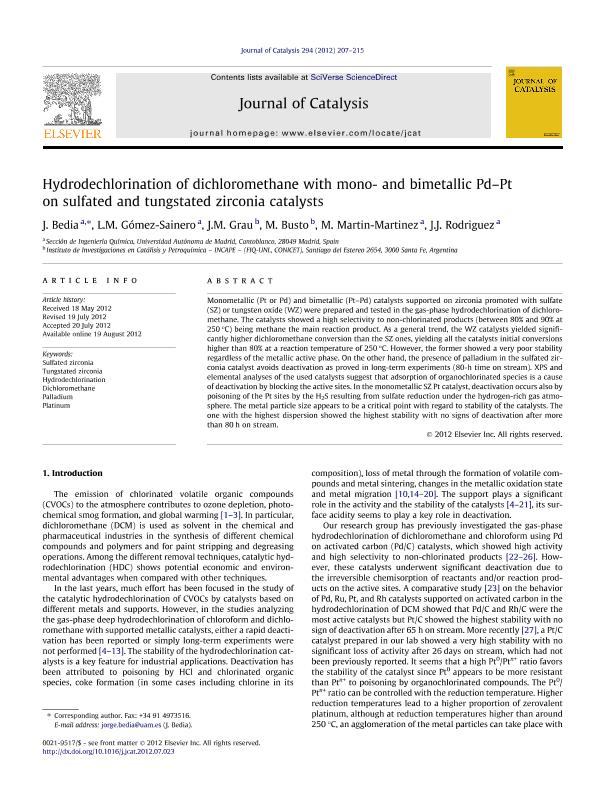Artículo
Hydrodechlorination of dichloromethane with mono- and bimetallic Pd-Pt on sulfated and tungstated zirconia catalysts
Bedía, J.; Gómez Sainero, L.M.; Grau, Javier Mario ; Busto, Mariana
; Busto, Mariana ; Martín Martinez, M.; Rodriguez Jimenez, J.J.
; Martín Martinez, M.; Rodriguez Jimenez, J.J.
 ; Busto, Mariana
; Busto, Mariana ; Martín Martinez, M.; Rodriguez Jimenez, J.J.
; Martín Martinez, M.; Rodriguez Jimenez, J.J.
Fecha de publicación:
07/2012
Editorial:
Academic Press Inc Elsevier Science
Revista:
Journal of Catalysis
ISSN:
0021-9517
Idioma:
Inglés
Tipo de recurso:
Artículo publicado
Clasificación temática:
Resumen
Monometallic (Pt or Pd) and bimetallic (Pt–Pd) catalysts supported on zirconia promoted with sulfate (SZ) or tungsten oxide (WZ) were prepared and tested in the gas-phase hydrodechlorination of dichloromethane. The catalysts showed a high selectivity to non-chlorinated products (between 80% and 90% at 250 C) being methane the main reaction product. As a general trend, the WZ catalysts yielded significantly higher dichloromethane conversion than the SZ ones, yielding all the catalysts initial conversions higher than 80% at a reaction temperature of 250 C. However, the former showed a very poor stability regardless of the metallic active phase. On the other hand, the presence of palladium in the sulfated zirconia catalyst avoids deactivation as proved in long-term experiments (80-h time on stream). XPS and elemental analyses of the used catalysts suggest that adsorption of organochlorinated species is a cause of deactivation by blocking the active sites. In the monometallic SZ Pt catalyst, deactivation occurs also by poisoning of the Pt sites by the H2S resulting from sulfate reduction under the hydrogen-rich gas atmosphere. The metal particle size appears to be a critical point with regard to stability of the catalysts. The one with the highest dispersion showed the highest stability with no signs of deactivation after more than 80 h on stream.
Archivos asociados
Licencia
Identificadores
Colecciones
Articulos(INCAPE)
Articulos de INST.DE INVEST.EN CATALISIS Y PETROQUIMICA "ING. JOSE MIGUEL PARERA"
Articulos de INST.DE INVEST.EN CATALISIS Y PETROQUIMICA "ING. JOSE MIGUEL PARERA"
Citación
Bedía, J.; Gómez Sainero, L.M.; Grau, Javier Mario; Busto, Mariana; Martín Martinez, M.; et al.; Hydrodechlorination of dichloromethane with mono- and bimetallic Pd-Pt on sulfated and tungstated zirconia catalysts; Academic Press Inc Elsevier Science; Journal of Catalysis; 294; 7-2012; 207-215
Compartir
Altmétricas



